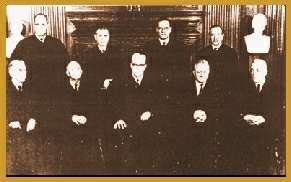5.3 The Supreme Court in Operation
5.3a A Judicial Review
A distinctive feature of American government is that the Judiciary is given the final authority to interpret the Constitution, as applied to contemporary conditions. Thus the Supreme Court exercises its power of judicial review when it invalidates an act of the Congress or of a state legislature, on grounds that it does not conform to constitutional powers and provisions. Thus many clauses have been changed to meet changing conditions, without the necessity of formal amendment. The power to hold an act of the Congress as unconstitutional was exercised first, in the case of ’Marbury versus Madison’. In this case, Chief Justice John Marshall pointed out that the Constitution was the supreme law of the land and had thus to be superior to any statute conflicting with it. This power was only used again in the Dred Scott case in 1857.
Judicial nationalism was also practiced
by the Supreme Court in order to favor the federal government at
the expense of the states. In 1819, judicial sanction was given
to the party in control of the national government to use implied
powers rather than strictly follow the powers enumerated by the
Constitution, in the famous case of ’Mc Culloch versus Maryland’.
Again, in the case of ’Gibbons versus Ogden’, the Supreme Court
struck down the an attempt made by New York to grant a monopoly
on the use of steam-propelled vessels within its territorial waters.
A substantial amount of New Deal legislation under President Roosevelt
was also invalidated, as for instance the National Industrial Recovery
Act and the Agricultural Adjustment Act. The President’s proposal
in 1937, to increase the membership of the Supreme Court so that
more liberal justices could be appointed, eventually failed.
However the Supreme Court began to show a more tolerant attitude towards social legislation and gradually shifted from a conservative to a liberal position. Thus the Supreme Court became concerned with human rights and pressed towards new frontons of idealism. Thus in ’Brown versus Board of Education’ the court rejected the idea of separate schools for Negro and white students to prevent "a feeling of inferiority as to their status in the community" and ruled that "in the field of public education the doctrine of ’separate but equal’ has no place."
5.3b The Appointment of Supreme Court Justices
The appointment of Supreme Court justices assumes great importance, owing to the power of the highest courts to determine public policy. Thus the President appoints the Supreme Court justices with the advice and consent of the Senate. These are possibly the most important appointments made as the justices serve a life-long term. From time to time, appointments have been made to pay political debts, or to show deference to a particular section of the country. At times, justices may have been appointed to give representation to a political party that would not have secured representation otherwise. However, it is seen that the maximum number of justices come from the ruling President’s political party.

Exhibit 5.3
Justices of the US Supreme Court
[next page]
|
Index
5.0
Introduction
5.1 The State Court System
5.2 The Federal Court System
5.3 The Supreme Court in Operation
Chapter
6
|